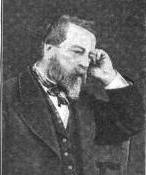Thomas Antisell facts for kids
Quick facts for kids
Thomas Antisell
|
|
|---|---|
 |
|
| Born | 16 January 1817 Dublin, Ireland
|
| Died | 14 June 1893 (aged 76) Washington, D.C., United States
|
| Known for | physician, chemist, and geologist |
| Spouse(s) |
Eliza Ann Nowlan
(m. 1841)Marion Stuart Forsyth
(m. 1854) |
Thomas Antisell was an amazing person who lived from 1817 to 1893. He was a doctor, a scientist, and a teacher. He also joined a group called the Young Irelanders who wanted Ireland to be independent. Later in his life, he fought in the American Civil War and even helped the government in Japan!
Contents
Early Life and Learning Adventures
Thomas Antisell was born in Dublin, Ireland, on January 16, 1817. He was the youngest son in his family. Thomas loved to learn and studied medicine at different schools. He went to the Dublin School of Medicine and the Royal College of Surgeons in London. He earned his medical degree in 1839.
He didn't stop there! In 1844, he traveled to Paris and Berlin to study chemistry. When he came back to Dublin in 1845, he became a teacher. He taught botany, which is the study of plants, at a medical school. He also opened his own clinic to help people.
Thomas was also a member of the Royal Dublin Society. He worked with another scientist named Robert Kane. Together, they wrote books about Ireland's geology (the study of Earth's rocks and soil) and chemistry.
Joining the Young Ireland Movement
In the 1840s, Thomas Antisell joined a group called the Young Ireland movement. This group wanted Ireland to be free and independent. In 1847, he became part of the Irish Confederation.
Thomas and five friends started a newspaper called The Irish Tribune. They wanted to share their ideas about freedom. But the government quickly shut down their newspaper after only five issues.
After the newspaper closed, Thomas moved to the United States in 1848. Some people think he left to avoid getting arrested. Even though he wasn't involved in politics anymore, he stayed good friends with John Mitchel, another important person from the movement. Thomas married his first wife, Eliza Ann Nowlan, in 1841. Sadly, Eliza passed away soon after they arrived in America.
Life in the United States
When Thomas Antisell arrived in New York City, he opened a clinic and a science lab. This was from 1848 to 1854. During this time, he also taught chemistry at several medical colleges.
Exploring the American West
From 1854 to 1856, Thomas worked as a geologist and botanist. He joined expeditions to southern Arizona, New Mexico, and California. He helped explore possible routes for a new railroad. His work helped people understand more about the geology of America.
In 1856, Thomas got a job in Washington, D.C. He worked at the United States Patent and Trademark Office. His job was to check new inventions related to chemistry. He also taught chemistry at Georgetown University. Over the years, he taught many subjects, including how to stay healthy and how the body works.
Serving in the Civil War
Thomas Antisell had different ideas from his friend John Mitchel about slavery. So, Thomas decided to join the Union Army during the American Civil War. He became a surgeon, helping wounded soldiers. He worked as a medical director and later was in charge of a hospital. He finished his service in 1865.
In 1854, Thomas married his second wife, Marion Stuart Forsyth. They had a large family with twelve children – six daughters and six sons!
Thomas also taught at other colleges. He was a Professor of Chemistry at Berkshire Medical College in 1848. In 1854, he taught at the Medical College at Woodstock, Vermont. From 1869 to 1870, he was a Professor of Chemistry at Maryland Agricultural College.
Working in Japan
In 1871, Thomas Antisell was one of many scientists hired to work in Japan. These scientists were called O-yatoi gaikokujin, or "foreign advisors." Thomas was chosen because he knew a lot about chemistry and geology. He went to Hokkaido, a northern part of Japan, to help with its development.
However, Thomas had some disagreements with the leader of the project, Horace Capron. They disagreed about whether Hokkaido's cold winters would make development difficult. Thomas also had problems with the Japanese government over his salary. Because of these issues, another geologist was hired, and Thomas's report was not included in the official records.
Thomas spent his remaining time in Japan working for the Ministry of Finance. He developed special inks used to print paper money. For his important work, the Emperor Meiji gave him a special award called the Order of the Rising Sun before he left Japan in 1876.
Later Life and Legacy
When Thomas Antisell returned to the United States, he received a PhD from Georgetown University in 1876. He went back to work at the Patent Office and stayed there until he retired.
Thomas wrote many articles for different journals. He wrote about topics like farm chemistry, plants, the ocean, city cleanliness, and animal diseases. He passed away in Washington, D.C., on June 14, 1893. He is buried in the Congressional Cemetery.
Books by Thomas Antisell
- A manual of agricultural chemistry, with its application to the soils of Ireland (1845)
- Irish geology, in a series of chapters, containing an outline of the science of geology (1846)
- Suggestions towards the improvement of the sanitary condition of the metropolis (1847)
- Home cyclopedia of the arts and manufactures (1852)

